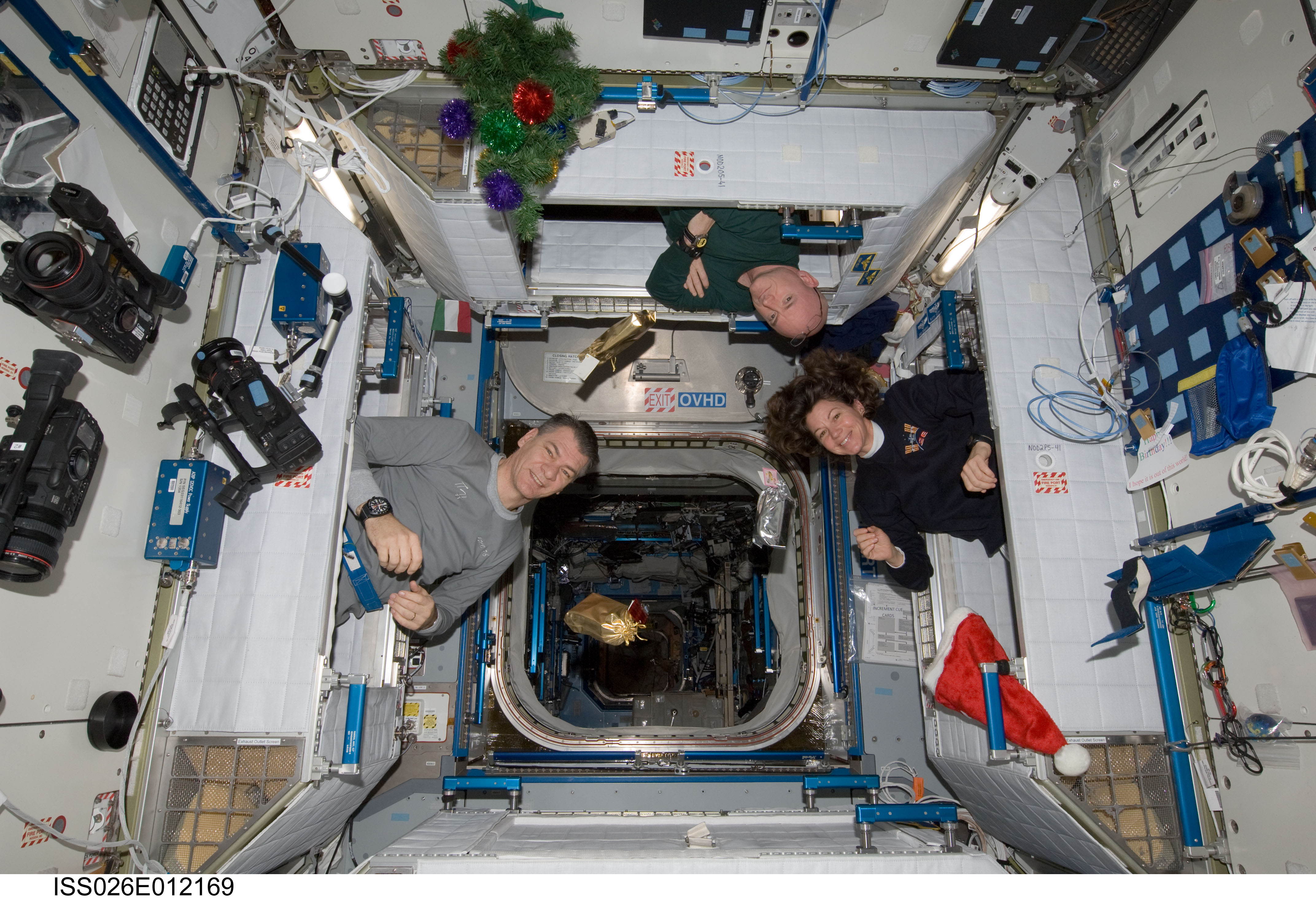
As we celebrate the Christmas period, spare a thought for the six men from three discrete nations who are presently in orbit, 250 miles (400 km) above Earth, aboard the International Space Station (ISS). Expedition 46 Commander Scott Kelly—who became the first U.S. citizen to spend as many as three Yuletides in orbit, following his stint aboard shuttle mission STS-103 in December 1999 and at the helm of Expedition 26, back in 2010—is presently joined by Russian cosmonauts Mikhail Kornienko, Sergei Volkov, and Yuri Malenchenko, NASA astronaut Tim Kopra, and Britain’s Tim Peake.
All six men are at various stages of their respective “increments” aboard the ISS, with Kelly and Kornienko just past the 75-percent-complete point of their year-long mission, Volkov more than halfway through his six-month expedition, and Malenchenko, Kopra, and Peake newly arrived at the multi-national outpost in the last few days. Yesterday’s AmericaSpace history article explored the Christmastime missions of the 20th century, from the historic flight into lunar orbit of Apollo 8 in December 1968 to the only shuttle mission ever to be undertaken over the festive season, STS-103 in December 1999. However, from the end of 2000 onward a continuous human presence in low-Earth orbit has seen Americans and Russians, Japanese and Italians, Dutchmen and Canadians, and, in 2015, a “Briton,” sponsored by the UK Government for the first time. All of these astronauts and cosmonauts have unwrapped their Christmas gifts in a seriously unearthly place.
Celebrating Christmas in orbit has become commonplace since the arrival of the first permanent ISS crew in the fall of 2000. For the last 16 consecutive Christmases, 28 Americans and 30 Russians have spent the holidays aboard the space station—several of them on more than one occasion—as well as two Japanese, two Italians, a Dutchman, a Canadian, and a Briton. For all of them, the sense of separation from family and loved ones is particularly strong.
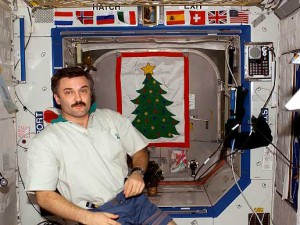
The first crew to put up decorations aboard the ISS were the Expedition 1 crew—Commander Bill Shepherd of NASA and Russian cosmonauts Yuri Gidzenko and Sergei Krikalev—who were about eight weeks into their five-month increment on the big day. For them, Christmas was a busy time, since an unpiloted Progress cargo craft had been undocked a few weeks earlier and inserted into a close “parking orbit” to allow Russian flight controllers to correct a software glitch with its automatic rendezvous system. On 26 December 2000, Gidzenko guided the Progress to a smooth docking at the rear port of the station’s Zvezda service module. Despite the work, the three men managed to enjoy a quiet Christmas, opening presents, talking to their families, eating rehydrated turkey, and even receiving Christmas greetings from NASA Administrator Dan Goldin.
A year later, the station had grown significantly, with the addition of the United States’ Destiny laboratory, the Quest airlock, and the Canadarm2 robotic manipulator arm. Christmas 2001 was observed by newly-arrived Expedition 4 Commander Yuri Onufrienko and his NASA crewmates Carl Walz and Dan Bursch with a day off and an opportunity to break into the pantry to sample turkey and other traditional foods. The following Christmas came just five weeks before the Columbia tragedy, and the Expedition 6 crew of Ken Bowersox, Nikolai Budarin, and Don Pettit also enjoyed a day with only minor duties. Whilst they were required to check the station’s environmental control system and the status of several Destiny payloads, each crewman opened presents, “selected favourite dishes for their holiday dinner” and spent 15 minutes privately talking with family members. They also spoke to NASA Administrator Sean O’Keefe.
Shortly afterwards, one of the worst years in the space agency’s history unfolded, but the ISS remained occupied, thanks to the assured crew return capability afforded by Russia’s Soyuz. Christmas 2003 was a shadow of what it should have been, with ISS construction having ground to a halt for all intents and purposes. Nevertheless, Expedition 8’s skeleton staff of U.S. astronaut Mike Foale and Russian cosmonaut Aleksandr Kaleri displayed not one Christmas tree, but two: a small artificial one and another embroidered onto a blanket. Christmas 2004 was celebrated by Expedition 10 crewmen Leroy Chiao and Salizhan Sharipov, who actually received a scheduled visitor that evening, in the form of a Progress resupply craft. In addition to its normal quota of food, propellant, oxygen, water, and experiment hardware, the Progress carried holiday gifts for the crew. A year later, with the first post-Columbia shuttle mission having flown, but the fleet grounded again, Expedition 12’s Bill McArthur and Valeri Tokarev spent a quiet day dining on packaged Russian foodstuffs, including soup and bread, fish and meat dishes, vegetables, and pastries. Poignantly, Tokarev paid tribute over the space-to-ground link to fellow cosmonaut Gennadi Strekalov, who had died a year earlier on the previous Christmas Day.
By the time the festive season rolled around in 2006, construction of the station had been driven back into high gear and long-duration crews had returned to their original three-strong capacity. Aboard the ISS were Expedition 14 Commander Mike Lopez-Alegria, his Russian crewmate Mikhail Tyurin, and the first American woman to celebrate Christmas in orbit, Suni Williams. For them, the big day fitted in the middle of a busy week unpacking, recording, and stowing supplies brought by the recent STS-116 shuttle visitors. In one of her Mission Logs, Williams noted that crew members were allocated a handful of off-days throughout the year and these were picked on the basis of operational constraints. “Remember we have our international partners here as well,” she wrote, “so not all holidays are ones that are observed in the U.S. I voted for taking all the holidays off, but that didn’t go over too well … ”
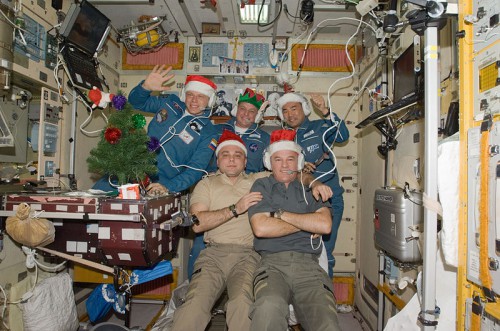
A year later, in 2007, the 20th continuous Christmas celebrated by humans saw the station’s first female skipper, Peggy Whitson, aboard the outpost, alongside Russia’s Yuri Malenchenko and NASA astronaut Dan Tani. The season was tinged with some sadness, for Tani’s mother, Rose, had been killed on 19 December when her car was struck by a freight train in Chicago, Ill. By Christmas 2008, the station had received its European Columbus and Japanese Kibo modules and Expedition 18 crew members Mike Fincke, Yuri Lonchakov, and Sandy Magnus were aboard.
Only two days before Santa’s arrival, Fincke and Lonchakov completed an EVA outside the Russian Orbital Segment, but their efforts were amply rewarded by Magnus, who prepared mesquite grilled albacore steaks, with a lemon and garlic paste sauce, together with Russian crab salad from the contents of her bonus food containers. She also made a point to request red, green, yellow, blue, and white icing among her foods to decorate some cinnamon, shortbread, and butter cookies, which she distributed to her crewmates over the festive period. According to NASA, Magnus’ efforts contributed to “the high-calorie traditions so common on Earth this time of year.” A quick glance at the crew’s Christmas dinner was more than adequate to whet the appetite: smoked turkey, cornbread dressing, and mashed potatoes, together with asparagus, shrimp cocktail, dried blueberries, various tropical fruits, wheat flatbreads, and brown rice.
Twelve months later, the mid-winter festivities appeared to have died down and until the final few days before Christmas 2009 only two men—NASA’s Jeff Williams and Russia’s Max Surayev—occupied the outpost. All that changed on 22 December, when Soyuz TMA-17 docked and brought the final three members of the Expedition 22 increment: Russian cosmonaut Oleg Kotov, U.S. astronaut Timothy “T.J.” Creamer, and Japan’s Soichi Noguchi. And they arrived in style. Floating from their craft into the station, the three men were attired in the costumes of Santa’s helpers and elves and bore a Christmas tree, topped by a dangling decoration of Mr. Claus himself, on their shoulders and a large white sack full of presents. Kotov manhandled the tree, whilst Noguchi carried the sack and Creamer, sporting genuine pointed ears and elven shoes, brought up the rear.
By this time, Christmases were turning into busy affairs at the orbital outpost, which had reached the capability to house a full crew of up to six long-duration occupants. Noguchi’s arrival made him the first Japanese to spend Christmas in space and Italy also added its name to the tally in December 2010, when Paolo Nespoli launched aboard Soyuz TMA-20, alongside Russian cosmonaut Dmitri Kondratiev and NASA astronaut Catherine “Cady” Coleman. Upon docking, they joined incumbent Expedition 26 crew members Scott Kelly, Aleksandr Kaleri—spending his third Christmas in orbit, following previous holiday stints aboard Mir and the ISS—and Oleg Skripochka.
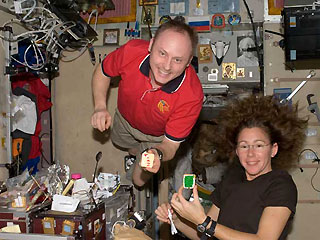
“The holidays are a time where we treasure being with our family and our friends,” said Coleman, in a pre-recorded Christmas message in the station’s Kibo module, as she floated alongside Kelly and Nespoli, “and we think about what we have and how much more we have than others do.” Nespoli added that from his vantage point, he saw just one planet and one world, with no borders, and his awareness of the enormity of humanity’s responsibility was clear. On Christmas morning, their crewmates from the Russian Orbital Segment photographed them bailing out of their sleep stations to eagerly access their gifts.
A year later, in 2011, NASA astronauts Dan Burbank and Don Pettit, Russian cosmonauts Anon Shkaplerov, Anatoli Ivanishin, and Oleg Kononenko and Dutchman Andre Kuipers were aboard the ISS, as the crew of Expedition 30. “My collateral damage toll,” wrote Pettit in an online NASA blog, “includes being on-orbit for two Thanksgivings, Christmas, New Year, birthdays, anniversaries, a science fair, school plays, recitals and Valentine’s Day.” With Expedition 30, he added, his damage toll was steadily rising, although he acquiesced that “with our new internet capability on space station, I can at least send flowers!” Humanity had come a long way from the tiny gifts of cufflinks and man-in-the-Moon and figure-8 tie pins from the Apollo 8 wives to their menfolk, and Pettit offered the tongue-in-cheek remark in his blog that the real essentials for surviving in the new “wilderness” of space “are not flint, steel, and powder … but your credit card number and network login.”
Since the dawn of the Space Age, and including the six-strong Expedition 46 team, some 92 discrete astronauts and cosmonauts have spent Christmas away from their loved ones, high above Earth. Among their number are Americans and Russians, Swiss and French, Germans and Japanese, Italians and Dutchmen—including Italy’s first female spacefarer, Samantha Cristoforetti—as well as Canadians and now a Briton. And with Scott Kelly becoming the first American to chalk up as many as three Christmases “spent off the planet,” he will join Russian cosmonauts Sergei Avdeyev, Sergei Krikalev, and Aleksandr Kaleri as the fourth member of one of the world’s most exclusive clubs, whilst 18 individuals, including NASA’s Mike Foale and Don Pettit, have spent two festive seasons in orbit.
For the combined crew of Expedition 46, Christmas Day was a time to reflect, as Expedition 26’s Cady Coleman said four years ago, upon how much more “we” have, materially, in comparison to others on our Home Planet. There will be time for them to privately speak to their families and share some of the holiday festivities. There will be time for them to open gifts and break into stockings and wear Santa hats, perhaps, and enjoy hearty (though often certainly thermostablised, rehydratable, or irradiated) Christmas fayre.
This is part of a series of history articles, which will appear each weekend, barring any major news stories. Next week’s article will focus on celebrations of New Year in space.
Be sure to “Like” AmericaSpace on Facebook and follow us on Twitter: @AmericaSpace




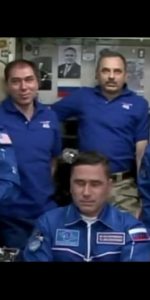

One Comment
One Ping
Pingback:Jeff Williams and ‘Sardines’ Top the U.S. Spaceflight Experience Table « AmericaSpace